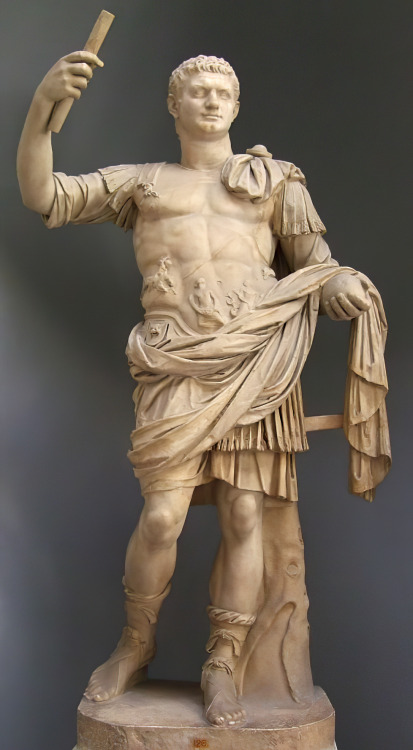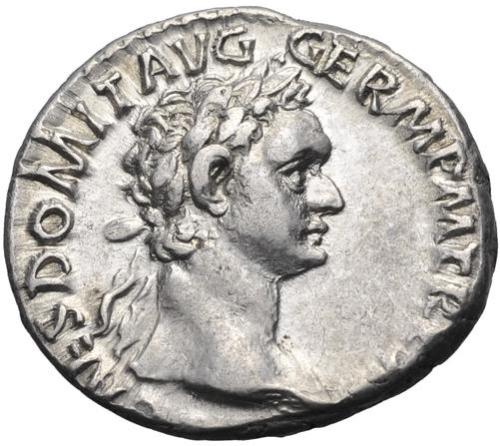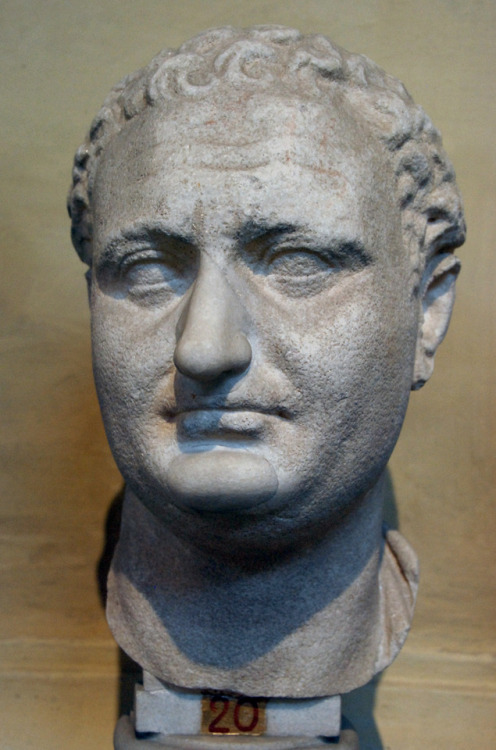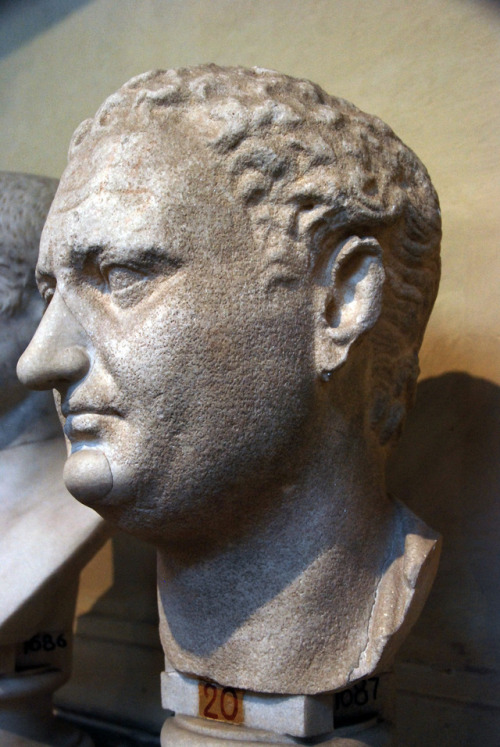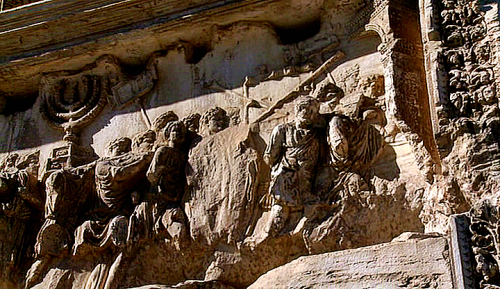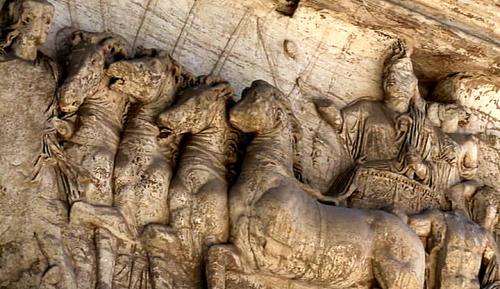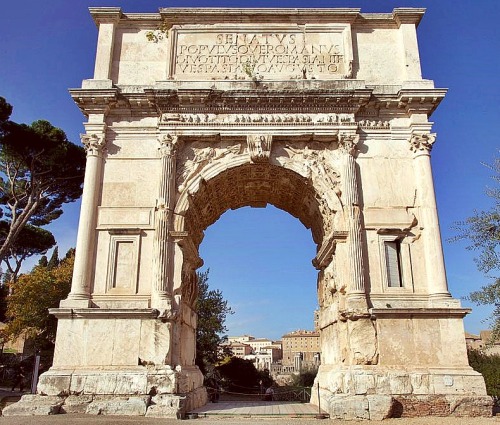#domitian
On this day (14 September) in 81 A.D., Domitian became Roman Emperor. The last member of the Flavian dynasty, Domitian (Caesar Domitianus Augustus) was the second son of Emperor Vespasian and brother to the Emperor Titus, whom he succeeded when the latter died unexpectedly from a fever.
Prior to taking the imperial throne, Domitian had acted as a praetor (a judicial officer) and was appointed as consul on six separate occasions.
According to the Roman historian Suetonius, Domitian (as a young aristocrat) possessed a “lawless” streak that foreshadowed his reign, which would ultimately be remembered mainly for the Emperor’s cruelty and viciousness.
Suetonius however, also informs his readers that there were many positive aspects to Domitian’s rule. He “presented many extravagant entertainments in the Colosseum and the Circus… nor did he ever forget the Games given by the quaestors.” The Emperor also “founded a threefold festival of music,” dedicated to the Capitoline Jupiter. Domitian additionally embarked on a programme to restore some of Rome’s most important buildings, while adding to the city’s architecture with new construction projects. These ventures included, “a temple to Jupiter the Guardian on Capitoline Hill, the Forum of Nerva, the Flavian Temple, a stadium, a concert hall and [an] artificial lake for sea-battles.”
In the theatre of war, Domitian also led various campaigns: some that were perceived as justified and others, which were considered unnecessary. For instance, Suetonius calls the conflict against theChatti, “uncalled for” and the war against the Sarmatians, justified.
The Roman historian also claimed that “Domitian made a number of social innovations.” These included cancelling the public grain issue, banning castration and increasing the number of official chariot teams from four, to six.
Conversely, Domitian’s cruelty was infamous and well-reported. Suetonius divulges that “he executed [a] beardless boy, in distinctly poor health, merely because he happened to be a pupil of the actor Paris.” When the emperor disagreed with the writings of Hermogenes of Tarsus, the Greek rhetorician was executed and “the slaves who had acted as copyists were crucified.” Members of Roman civic society also lost their lives during Domitian’s reign of fear. Suetonius reveals that Civica Cerealis, Acilius Glabrio and Salvidienus Orfitus were “accused of conspiracy” and summarily executed. Aelius Lamia however, was killed because he voiced a sarcastic comment and Salvius Cocceianus “died because he continued to celebrate the birthday of the Roman Emperor Otho.”
Consequently, Domitian’s cruelty and autocracy earned him the disdain of the senate and he was assassinated on 18 September, 96 A.D.
References: Suetonius, The Twelve Caesars, trans. Robert Graves, revised with an introduction by Michael Grant, London: Penguin Books, 1979, pp. 303-319.
Images:Statue of Emperor Domitian, 1st Century A.D., marble, Vatican Museums, Vatican City, Rome. Wikimedia Commons.
Bust of Domitian, 1st Century A.D., marble, Musée du Louvre, Paris. Wikimedia Commons.
A Denarius of Domitian. Wikimedia Commons.
A Sestertius of Domitian. Wikimedia Commons.
Statue of the Roman Emperor Domitian, Vaison-la-Romaine, France. Wikimedia Commons.
Post link
“A terrifying example of alluding to the cult of the dead at a dinner party, however, can be found in the ‘Black Dinner’ given by the emperor Domitian. The evocation was as eerie as the uncertainty as to the Emperor’s message by his evocation.
According to the historian Dio (Epitome 57.9), Domitian invited prominent senators and knights to dinner that was held in an entirely black room that evoked a tomb. Gravestones inscribed with the names of guests and tomb lamps were placed near each guest who reclined on funeral couches. Boys painted black assumed the roles of the guests’ death spirits and sat at their feet as black funeral offerings and sacrifices were served to the guests on black dishes. The emperor alternated between deadly silence and conversation about death as if the guests were already among the dead.
After the dinner, the tombstone and other dinner serving pieces were brought to the homes of the guests, who were expecting imminent death. As though to signal their return to life, however, the boys who had been painted black as their death spirits returned washed and dressed in white.”
Death: Antiquity and Its Legacy by Mario Erasmo, pg. 130.
Emperor Domitian. 81-96 AD. Marble. Staatliche Museen zu Berlin, Altes Museum. Sk 351
myglyptothek: Faces of ancient Rome
Post link
Emperor Titus (reworked portrait of Domitian). After 96 AD. Marble. Musei Vaticani. Inv. 1687
myglyptothek: Faces of ancient Rome
Post link
Ancient Worlds - BBC Two
Episode 6 “City of Man, City of God”
TheArch of Titus (Arcus Titi) is a triumphal arch located at the entrance to the Forum Romanum, at the highest point of the via Sacra.
The arch was constructed in 81 AD by the Roman Emperor Domitian shortly after the death of his older brother Titus (Emperor from 79 to 81 AD) to commemorate the victories of his father VespasianandTitus in the Jewish WarinJudaea.
In 66 AD Jewish Zealots started a revolt against the Roman occupation of Judaea. Vespasian was sent from Rome to suppress the revolt. After Vespasian became emperor, his son Titus took over command of the troops. The siege of Jerusalem in 70 AD was the decisive event of the war. The city was sacked, its famous Second Temple destroyed and its vast riches plundered.
The original inscription on the east side of the arch is still in situ. Originally the letters would have been inlaid with gilded bronze. It reads:
“SENATUS POPOLUS QUE ROMANUS DIVO TITO DIVI VESPASIANI F(filio) VISPASIANO AUGUSTO” - The Roman Senate and People to the divine Titus Vespasianus Augustus, son of the divine Vespasian
The south panel depicts the spoils taken from the Temple in Jerusalem, carried on litters in a triumphal procession, amongst then the silver trumpets and the seven-branched golden Candelabra(Menorah), carved in deep relief. The north panel depicts Titus as Triumphator,riding a four-horse chariot (quadriga) and shows him being crowned by a personification of Victory.ThegoddessRoma stands in front, holding the bridle of one of the horses. This is one of the first examples of divinities and humans being present in one scene together.
The arch of Titus is one of Rome’s oldest and most well preserved arches. It has provided the general model for many triumphal arches, like the Arc de Triomphe in Paris, France.
Post link
FORUM ROMANUM VI





TEMPLUM DIVI VESPASIANI
The Temple of the Divine Vespasian was begun by Titus after the death of Vespasian in AD 79, but finished and dedicated by Domitian after the premature demise of Titus in AD 81. Some scholars have hypothesized a dual dedication to both the deified Vespasian and Titus. The inscription on the architrave (recorded in the Einsiedlen Itinerary), however, cited Vespasian only (DIVO VESPASIANO AVGUSTO S. P. Q. R.). The Temple of the Divine Antoninus Pius and Faustina cites both dedicatees in that temple’s surviving inscription, which suggests that Titus would have been mentioned had his cult been established in the same temple as his father’s. The omission of Titus may attributed to Domitian’s hostility towards his brother or to the fact that Titus’ death had been commemorated in the Forum already by the arch bearing his name.
The Temple of the Deified Vespasian is sited in the highly-congested western end of the Forum Romanum, between the Temple of Concordia and the Temple of Saturn. When complete, it nearly abutted the Tabularium and obscured much of its façade. The previous temples of the imperial cult, dedicated to Augustus and Claudius, had been built outside the forum where sufficient land allowed for the construction of imposing edifices. The Flavians, however, chose this chose this cramped space in order to establish a dynastic presence in the Forum. The temple would also serve as a counterweight to the Temple of the Deified Julius Caesar, which stood at the eastern end of the Forum, and to the other monuments built by the Julio-Claudians. The site did have one advantage: located at the foot of the Clivus Capitolinus, the temple was highly visible during triumphs and other civic ceremonies that terminated on the Capitoline Hill.
The temple is hexastyle, prostyle and pseudo-peripteral. It stood on a high, marble faced podium and had a façade orientation. The odd proportions of the temple (33 m x 22 m) were dictated by the area available. The scant physical remains consist of the podium, three fluted Corinthian columns supporting a section of the architrave, and, inside the Tabularium, a large chunk of the entablature.

The latter is virtual compendium of Roman decorative motifs including dentilation, egg and dart, rosette coffering, brackets, and a large frieze depicting bucrania and the implements used by the priests of the temple in the performance of sacrifices. Dense, ostentatious ornamentation is a hallmark of Flavian style, perhaps reflecting desire of the usurping dynasty to project an image of richesse.
A second inscription, also preserved in the Einsiedeln Itinerary, appears on the architrave, the final word of which is still extant:
IMPP. CAESS. SEVERVS ET ANTONINVS PII FELIC[ES] AVGG. RESTITVER[ENT]
Archaeological evidence suggests that the restoration of the temple around AD 200 by Septimius Severus and Caracalla was minor act undertaken for its propagandistic value of linking the Severus to the previous—and highly-admired—usurper, Vespasian.
The temple was largely demolished by Nicholas V as part of his reorganization of the Forum Romanum.
FORUM ROMANUM SERIES
I. Arch of Titus
II. Lacus Juthurnae
III. Arch of Septimius Severus
IV. Tabularium
V. Basilica Iulia
VI. Templum Divi Vespasiani

